18 Different Types of Tourism | Globally Accepted
Over the last few years, tourists’ demands have undergone frequent changes, and the tourism industry has adapted accordingly to meet these needs. This article elaborates on different types of tourism, including tourism planning, activities, products, travel, etc. It will help your travel planning.
Along with recreation, tourism has become one of the fastest-growing industries, providing a source of income for many people.
“Life is all about adventure, so pack your bags and start the tour.”
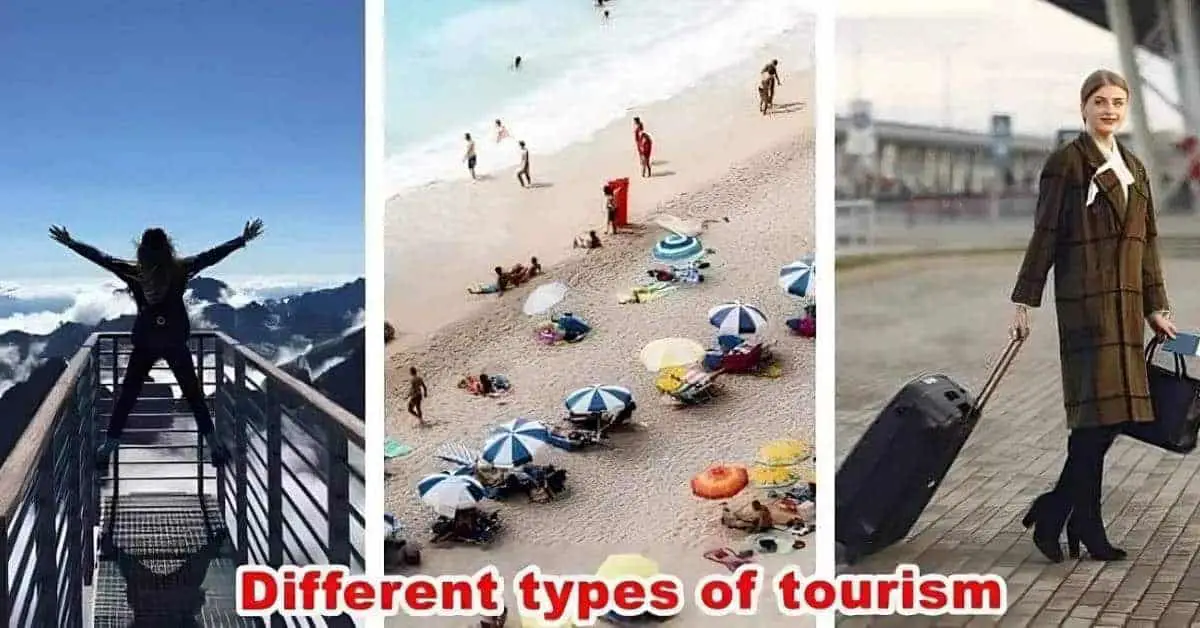
Different Types of Tourism
What is Tourism?

Tourism involves spending time away from one’s daily routine or home to pursue recreation, relaxation, and pleasure while utilizing commercial services.
Tourism has numerous benefits for a country, including creating employment, boosting revenue, developing infrastructure, and facilitating cultural exchange. The travel duration under tourism must be less than 12 months (consecutive years).
So, what comes first to mind when we hear the word Tourism?
The most common thought is to pack the rucksack and travel away from day-to-day life. That means people move from their usual residences to other places.
Suppose your friend’s aim for the tour might differ from yours. For example, you may travel for recreation, but he may go for business.
Classification of Tourism
According to the United Nations World Tourism Organization (UNWTO), tourism involves the movement of people within a country’s natural environment or outside the country for personal or other purposes. These different purposes classify the tourism industry in many ways.
This article lists the main tourism classifications: domestic tourism, International tourism, Business tourism, Adventure tourism, Medical tourism, and Educational tourism.
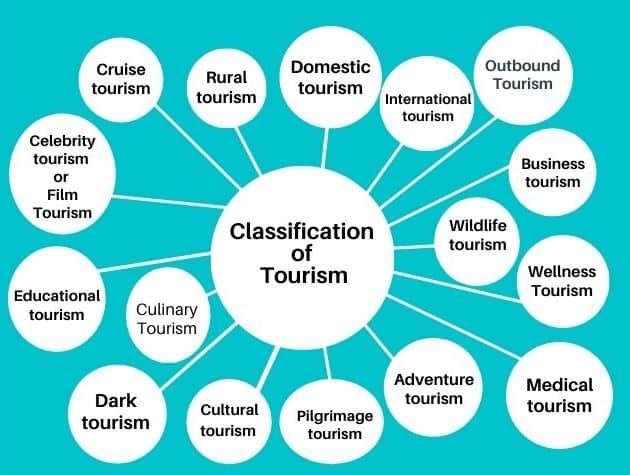
Importance of Tourism – Why is tourism Important?
Tourism has a direct impact on any country’s economy. Its role in economic development is important. Public relations in tourism can create a vast number of job possibilities. Knowing another state or country’s taste culture is a great feeling from a traveler’s perspective.
How many types of tourism are there?
There are three main types of tourism in any country: domestic, International, and outbound. However, many new types of tourism have emerged in recent years.
18 Different Types of Tourism
The various types of tourism are developed nowadays and have become popular; they are:-
- Domestic tourism
- International tourism
- Outbound tourism
- Business tourism
- Adventure tourism
- Wildlife tourism
- Medical tourism
- Wellness tourism
- Pilgrimage and spiritual tourism
- Cultural tourism
- Dark tourism
- Culinary tourism
- Celebrity tourism or Film tourism
- Educational tourism
- Cruise tourism
- Rural tourism
- Beach tourism
- Space tourism
Let’s discuss how many flavors and categories of tourism can be found in any country and accepted globally.
1. Domestic Tourism
Domestic tourism involves traveling within one’s own country, and tourists don’t cross international borders or entry points. It is used to minimize poverty, enhance infrastructure, boost economic growth, and create employment opportunities.
2. International Tourism
Travel outside your country requires a visa and passport; this is called international tourism. For example, if you want to explore the UK from Sri Lanka, you need documents to enter another country.
Read How to Listen to Music on a Plane
3. Outbound Tourism
This type of tourism refers to a tourist traveling for a holiday to a different country, such as residents in Bali, or traveling to Barcelona. It is an example of outbound Tourism.
4. Business Tourism
This tourist travels to meetings, officially attends conferences, and so on.
Business tourism plays a vital role in the tourism sector. Sometimes, people leave their typical environment for more than a year for business purposes and spend their vacations there.
General activities related to business tourism include attending meetings, official gatherings, conferences, seminars, visiting exhibitions and trade fairs, among others. This tourism increases purchasing power.

5. Adventure Tourism
Adventure tourism involves traveling from one place to another to seek fresh adventures and activities. This form of tourism is most popular among young tourists and those who enjoy exploring remote areas. It encourages us to leave our comfort zones by undertaking hiking, rafting, climbing, diving, etc.
Adventure tourism is increasing daily. For adventure, you could also try whitewater rafting, the Ladakh tour, the Kedarnath tour, Port Blair, or the Andaman and Nicobar tour.

6. Wildlife Tourism
Wildlife tourism involves traveling to various locations to observe and interact with wildlife, flora, and fauna in their natural habitats. Safaris, visiting the animal rescue center, swimming with dolphins, and other activities are examples of wildlife tourism.
Due to the exotic wildlife, tourism gained recognition. The Sariska Wildlife or Hyde Park Sanctuary, Keoladeo Gana National Park, and Corbett National Park are renowned for wildlife tourism. The Great Barrier Reef is also famous in Australia.
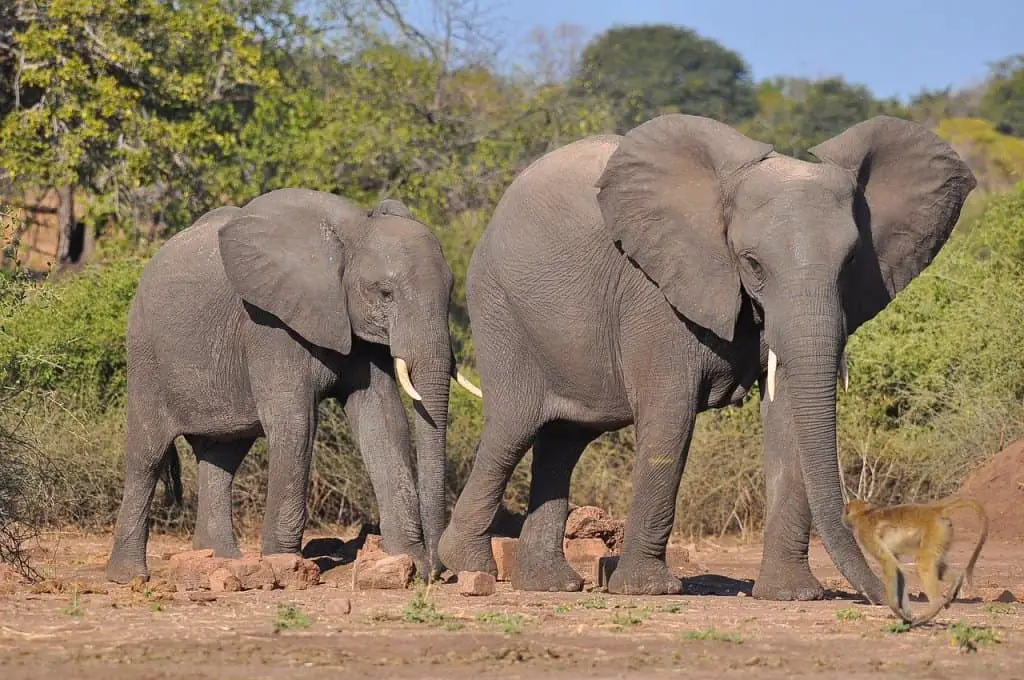
7. Medical Tourism
Many people travel for treatment, and several medical institutes treat foreign patients. Thailand records 6000,000 new patients every year. Malaysia also treated over 100,000 tourists in 2005. Approximately 45% of foreign tourists visit Chennai for medical treatment.

8. Wellness Tourism
Wellness tourism has been a significant part of tourism since ancient times. It primarily attracts tourists seeking to rejuvenate their health. Wellness tourism can help alleviate mental and physical stress.
Tourists recover from health issues through physical, spiritual, or psychological activities. Numerous destinations worldwide are renowned for their health-improving benefits.
Examples include Mexico Temazcal Beach Resort Spa, Caribbean wellness cruise, California weight loss and detox retreats, Colorado Hiking and Mountain Yoga retreat, and China Hot Spring Resorts TCM.
Ayurveda, yoga, meditation, panchakarma, and rejuvenation therapy are the oldest treatments for improving health and are the best ways to develop wellness tourism.
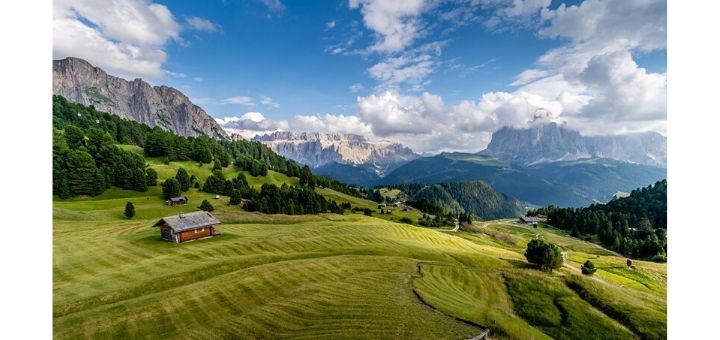
9. Pilgrimage and Spiritual Tourism
Pilgrimage or spiritual tourism refers to a person’s journey to other places for spiritual or religious reasons.
Spiritual tourism helps support local cultural activities and handicrafts, generating employment and revenue. Trips to Jerusalem, Bodh Gaya, and the Hajj, among others, are considered pilgrimages or spiritual tourism.
This tour has been famous for ages, but is mainly popular among older people. Vaishno Devi, Golden Temple, Char Dham, and Mathura Vrindavan are some places famous for Pilgrimage tours.
10. Cultural Tourism
Cultural tourism is a person’s journey to learn about and participate in the local festivals, rituals, and cultural activities of other places. It’s more than a commercial activity.
This form of tourism helps spread the culture, traditions, diversity, and richness of Aboriginal communities to the rest of the world.
Visit the historical sites and the artistic features of that country, too. Famous cultural tourist places are:-
- India: Durga puja in Kolkata, Temples at Banaras, Jaipur, the pink city, Palace in Rajasthan, and forts and monuments in Delhi, Agra, and UP.
- UK: Tower of London, The British Museum, Big Ben, London Durga puja, etc.
- Kenya: The main attraction is the dance of the Maasai tribe.
- Morocco: The main attractions are the Olive Festival and the Honey Festival.
- Jordan: The main attractions are Jerash, famous for Roman architecture; Petra, the red-rose-curved rock city and one of the seven wonders of the world; and Shoubak, which has its Montreal Crusader Castle.
- Greece: The main attraction is the Lion Gate of Mycenae.
- Turkey: The main attraction is Sultan Ahmed. Mosque, House of the Virgin Mary.
- Vietnam: The main attraction is the Sapa Market.
- Ireland tour: Cliffs of Moher, Dublin, Killarney National Park, etc.
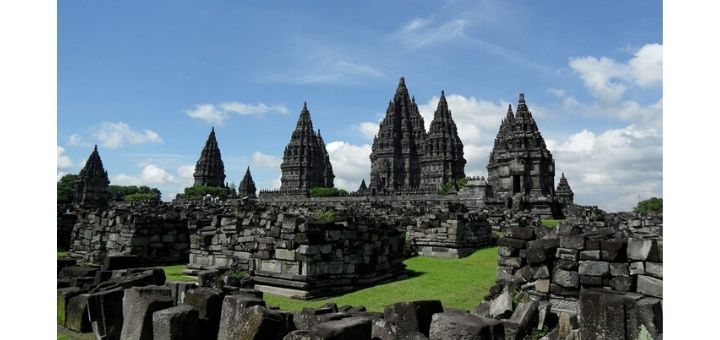
11. Dark Tourism
Dark tourism, Black tourism, or grief tourism are related to people’s travel to historical places involved with tragedy and death. Since 2016, dark tourism has increased significantly (by over 1200%). Chornobyl, cemeteries, Ground Zero, historical museums, and Auschwitz are popular dark tourism destinations.
It is referred to as mourning tourism. Dark tourism involves visiting places and sites that have witnessed the greatest tragedies in history. In addition to their history of human suffering and bloodshed, these locations are famous for their historical value.
Therefore, sites that carry potent pesticides have become popular tourist destinations, attracting many tourists each year.
Like Famous sites in Japan, Hiroshima & Nagasaki bombing locations, Ground Zero, New York, USA. The War Remnants Museum, Ho Chi Minh City, Vietnam; Auschwitz concentration camp, Auschwitz, Germany; Tuol Sleng Genocide Museum, Phnom Penh, Cambodia, etc.
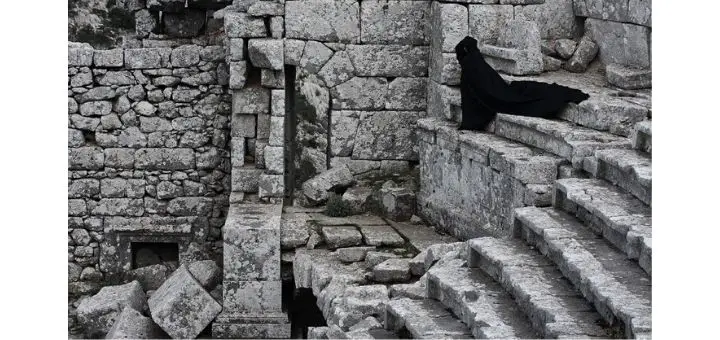
12. Culinary Tourism
Culinary or food tourism involves tasting and experiencing local and traditional food in a specific country, region, city, town, or village.
It is significant that, besides accommodation and infrastructure, food is one of the prime components here. Therefore, lots of tours are organized to experience the culinary culture.
Today, with the overall growth of this sector, tourism has expanded and developed to the next level.
Every year, Different states in India organize food festivals at various times. Thousands of people from abroad join this festival to enjoy traditional food.
Everyone knows India is called “the land of spices.” Every state has a unique food culture, a significant part of tourism today.
Culinary Tourism includes places where people visit specific regions, such as California’s Napa Valley, Catalonia, and the USA, to enjoy local wines.
Famous Destinations: London, France, Beijing, Mexico, Italy, etc.

13. Celebrity Tourism or Film Tourism
Celebrities are the primary source of attraction for celebrity or film tourism. In this form of tourism, tourists visit places where a celebrity currently lives or has lived. Management organizations use celebrity tourism to promote a place or attraction.
Although no celebrities are present, you are the only one who can see the entire studio. Many Destination Management organizations (DMOs) utilize celebrity tourism to promote their destinations as attractions.
Popular celebrity tourism destinations include Hollywood, the Harry Potter Studios, Ramoji Film City in India, the Cannes Film Festival, Hong Kong, and Madame Tussauds.

14. Educational Tourism
Educational tourism is a new pattern of tourism that involves learning new things. It involves leaving one’s hometown or country for educational or learning purposes. Educational tourism is popular in Japan, Australia, the UK, and other countries.
An educational tourist can be away from their hometown for many days. Education and learning are the primary reasons for their travels, which include learning about historical places, cultural and social events, and understanding a new language.
It’s used as a tool to complement education by gathering travel experience. Many educational institutes combine these trends in primary schools, which are compulsory in higher education.
15. Cruise Tourism
Holidays based partially or wholly on a cruise ship are considered cruise tourism. It provides tourists with a multi-centered holiday experience. Cruise ships (like small yachts, big ships, etc.) take people on a tour of oceans, fjords, or rivers.
Throughout their trip, tourists can enjoy time at various destinations. The Mediterranean, Caribbean, Arctic, Antarctica, and other regions are renowned destinations. It’s the newest and fastest-growing part of the world’s tourism industry.
The world’s famous coastline and inland waterways have the potential to develop cruise and houseboat tourism, such as Quark Expeditions, OZ Cruising, and A-ROSA River Cruises.
India offers a variety of tourist cruises. Soon, India will include ocean, river, and lake cruises.
16. Rural Tourism
There are many forms of tourism, and they are divided into many parts. In this category, tourists spend their leisure time in rural areas or villages. Visitors can plan to spend a few days or a couple of months in the rural area.
Solo travelers can especially visit those places to enjoy their lonely time. They participate in all the local activities that take place in this village.
Rural tourism is included in a ‘country holiday’ where tourists spend much of their leisure time. Thus, they engage in recreational activities in rural environments.
Examples include farming in Rural Punjab, the Spiti Valley Rural Tourism, Jodhpur Village Life, and Community Tourism in Kutch.
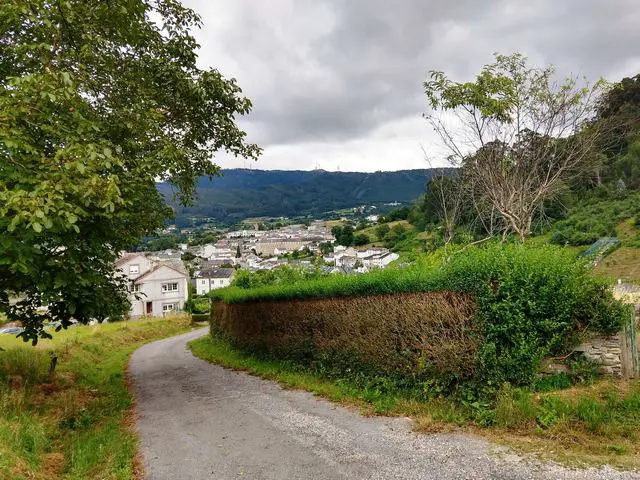
17. Beach Tourism
Beach tourism is when a beach plays a major role in a holiday. It’s the most modern form and the staple of tourism.
In beach tourism, tourists travel to a beach for leisure, recreation, or business purposes. People who like the clear blue sight of a beach undertake this journey.
Popular Beach Destinations include the Maldives, Seychelles, Turks and Caicos, French Polynesia, Africa, Queensland, Australia, the Philippines, Thailand, Bali in Indonesia, Lakshadweep, Goa, and Puri.
Why is Beach Tourism important?
- Beach tourism has generated numerous economic benefits.
- It has led to the construction of many attractions, resorts, and other developments.
- Beach resorts help meet the increase in intra-regional and domestic demand.
- This type of tourism creates numerous employment opportunities.

Negative Impacts of Beach Tourism
- It leads to the wastage of numerous resources and space.
- Beach tourism pollutes water and environmental resources.
- Building new berths, marinas, etc., hurts coastal and marine life.
18. Space Tourism
The aviation industry has undergone significant changes in the last 100 years. What was once used for warfare and cargo transport is now used for traveling.
Human development has now broken all bounds to take this journey to the vast emptiness of space.
Russia has been a pioneer in this field. In April 2001, the Soyuz spacecraft conducted its first space trip with American businessman Dennis Tito.
It was a government spacecraft that conducted seven space expeditions within the next six years.
This surge in public interest led other organizations worldwide to dive into this area.
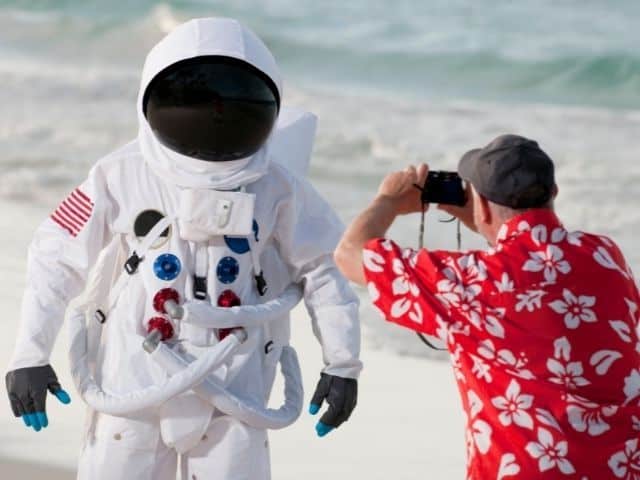
There are different types of space tourism
Orbital Space Tourism: These flights remain within an orbit around the Earth at a speed higher than suborbital space flights. These flights orbit the world constantly for their entire stay in outer space.
Sub-orbital Space Tourism: This was the beginning of space tourism. The spacecraft launches with a substantial initial velocity that pushes it out of the Earth’s atmosphere. But this doesn’t throw it entirely out of the gravitational sphere. The power is insufficient for orbiting, so it freezes once the engines are shut off.
SpaceX CEO Elon Musk proposed the prospect of lunar tourism. In 2018, he announced the ‘Dear Moon Project,’ the highly anticipated first lunar space tourism mission. They will carry out this project in 2022 with Japanese billionaire Yusaku Maezawa.
Space Tourism cost
The cost of each sub-orbital trip on the Soyuz spacecraft is reported to be 200,000-250,000 million U.S. dollars. Other trips carried out by different organizations were priced at a similar margin.
Virgin Galactic recently announced that each ticket would cost 450,000 USD for the upcoming missions.
Space Tourism companies
Although the industry is still emerging, large companies dominate the market. Space Adventures of Virginia, U.S.A., was the first successful space tourism company.
Elon Musk’s SpaceX, Richard Branson’s Virgin Galactic, and Amazon C.E.O. Jeff Bezos’s Blue Origin are all set to launch their space tourism business by 2022. Blue Origin recently conducted its debut flight with Jeff Bezos.
Oliver Daemen and Wally Funk were the world’s youngest and oldest men in space, respectively.
Space Tourism advantages
The universe and outer space have always been intriguing subjects for people on Earth. Yet, there were limited resources to satisfy their curiosity. The option of space tourism thus connects people with space in a unique way, solving the mystery of space. A more ecological advantage is the waste policy.
These travels are associated with minimal pollution. This opens up a whole new sector of job opportunities for highly educated professionals and ambitious youth.
Top 13 list of space tourists
- Dennis Tito (American): April 28 – May 6, 2001
- Richard Branson
- Gennady Padalka
- Guy Laliberté
- Eytan Stibbe
- Sian Proctor
- Mark Shuttleworth (South African / British): April 25 – May 5, 2002
- Gregory Olsen (American): October 1 – October 11, 2005
- Anousheh Ansari (Iranian / American): September 18 – September 29, 2006
- Charles Simonyi (Hungarian): April 7 – April 21, 2007[8]
- Richard Garriott (American): October 12 – October 23, 2008[9]
- Sheikh Muszaphar Shukor (Malaysian): October 10 – October 23, 2007
Space Tourism in India
Space activities, in general, have been quite a staggering sector in India. Last year, the government announced a policy opening space exploration to the private sector, but hardly any companies have taken action on it.
Entrepreneur Santhosh George Kulangara will be the first Indian space tourist as he booked his spot on a Virgin Galactic space flight in 2007. Hopefully, he will join Dennis Tito, Mark Shuttleworth, Gregory Olsen, and many more this year.
Forms of Tourism
- Atomic Tourism
- Beach Tourism
- Bicycle Tours
- Eco-Tourism
- Geo-Tourism
- Industrial Tourism
- Rural Tourism
- Space Tourism
- Sports Tourism
- Sustainable Tourism
- Virtual Tourism
- War Tourism
What is the main purpose of tourism?
- Economic Sustainability: It ensures the effectiveness and competitiveness of tourism destinations and enterprises. It helps continue improvement, which is beneficial in the long run.
- Local enrichment: The prosperity of tourist destinations is a significant aspect of tourism. The tourism industry continuously contributes to the economic growth of the host destination.
- Employment Standards: Tourism supported the level of wages, terms of service, and availability for all. It creates local jobs without discrimination based on gender, race, disability, or other means.
- Local management: Involve local communities and empower local people in planning and decision-making. The community and tourism management team contributed to its development.
- Community Welfare: Enhance and support the local community’s quality of life, as they are part of social structures. This process should take place without social humiliation or exploitation.
- Natural Integration: Maintain and improve the quality of both urban and rural landscapes. It avoids natural and visual degradation of the environment.
- Natural Integration: Maintain and improve the quality of both urban and rural landscapes. It avoids natural and visual degradation of the environment.
- Biodiversity: Another purpose of tourism is to help conserve wildlife and natural habitats and reduce losses.
- Environmental cleanness: In addition to the purpose of tourism, all tourists must reduce air, water, and land pollution and waste generation.
- Tourism plays a significant role in national integration.
- Tourism often motivates tourists to learn about the traditions, heritage, culture, and religion of the places they visit.
- Tourism’s most significant part is economic growth, or the business part of the destination. It encourages local people to create handicraft items and prepare local food, souvenirs, and dresses for sale.
- Tourism is one sector that consistently boosts the country’s economy.
Niche Tourism
This type of tourism focuses on a specific aspect of travel. It also focuses on the interests of the consumer market segment. It makes the destination more exciting and marketable. Niche Tourism is one of the fastest-growing sectors.
Niche tourism refers to a specific type of travel.
For example, some tourists want to visit a museum, others wish to see old architectural monuments, buildings, and palaces, while some want to dine at a famous restaurant. Thus, niche Tourism shows a particular activity that is not the only focus of travel.

Types of Niche Tourism
- Macro-Niche
- Micro-Niche
What is Macro-Niche?
Macro-niche tourism can be explained as a niche with broad customer interest categories, such as rural tourism, Business tourism, sports tourism, medical tourism, and environmental travel, among others.
What is Micro-Niche?
It is a small group trip that combines gastronomy tourism, cycling tourism, and geo-tourism.
Niche tourism in South Africa
South Africa is an attractive destination due to its wide diversity of animal and bird species. Tourism professionals have found that this country has considerable potential.
Advantages of Niche Tourism
- Even if niche tourism is smaller than mainstream markets, it has a broader reach.
- It has more potential to grow.
- It creates quality jobs that require specialized skills.
What are the different types of tourists?
When we visit a place, we find different kinds of travelers. The aim of each traveler is different. Let us discuss the types of visitors. Five types of tourists are found mostly:-
- Incentive tourists: These tourists did not plan their tour in advance. Suppose you were rewarded with two tickets from the office because of your performance. You and your colleagues went on the trip.
- Business tourist: This type of tourist travels for business. They will always prefer a hotel with a conference room. They don’t come to enjoy luxury but want the hotel to serve everything on time.
- Leisure tourist: This type of tourist comes to enjoy the vacation. They love hotels that offer something extra, like drinks. They choose hotels that provide the best comfort and luxury.
- Special interest tourists: They often plan their tours very well. This tourist doesn’t need comfort but loves to have adventures.
- The Foodie tourist: This type is quite common. They wish to experience various foods in different places, including the signature dishes of those areas and other types of cuisine.
Types of Tourist Attractions
We have to keep in mind that attraction varies from person to person. For example, suppose Rahul and Sheela are traveling to Kashmir. Rahul is interested in climbing the mountains to see snowfall, whereas Sheela is excited to visit the temples in Kashmir.
Tourist attractions could be classified into the following two categories:-
- Natural Attraction – If you are a nature lover, don’t miss The Valley of Flowers in Uttarakhand, also known as Coorg, often referred to as the ‘Scotland of India.’
- Events and heritage attractions—Goa is a place for heritage lovers. So pack your bag, take the camera, and start your journey. I am sure you will have an unforgettable experience learning about Goa’s history. Fort Aguada, Chandor, and some famous museums are places to visit.
What is Tourism Planning?
Perfect planning is always crucial to the success of any activity. Whenever we plan something and implement it, we get a better result. It’s the same with tourism. But it is neither guaranteed nor forever. It’s a process where the people’s needs are determined using the best resources, programs, and activities.
How do these tourism plans help us?
A tourism plan creates guidelines for areas, helping the government and private sectors develop them. Most importantly, we must remember a few steps involved in tourism planning.
Main types of tourism planning
- Financial planning
- To establish the objective
- Human resource planning
- Monitoring progress
- Human resource planning.
Types of Tourism Activities
There are various kinds of tourism activities. Like-
- Boat tour
- Hiking
- Game drive
- Heritage trails
- Swimming with dolphins
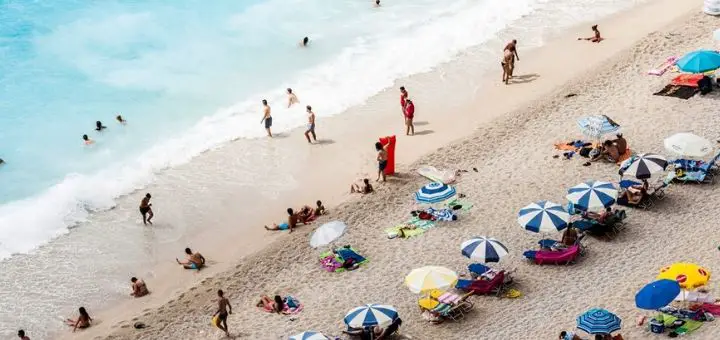
Name of some international tourist organization-
- American Society of Travel Agents: Founded in 1931, Headquarters- New York
- International Academy of Tourism: Founded-1951, Headquarter- Monge Carlo
- International Bureau of Social Tourism: Founded in 1963, Headquarters- Brussels
- International Touring Alliance: Founded-1919, Headquarters- Europe
- World Tourism Organization: Founded in 1975, Headquarters- Madrid.
Types of Tourism packages
Everybody in different categories of tourists needs a separate package. Let’s discuss the various types of Packages that are available.
1. Adventure Tourism Package
This type of tourism encourages people to step out of their comfort zone and experience the thrill of nature more closely. People are taking adventures more often. It has shown potential growth in recent years.
The most exotic and adventurous destinations are Ladakh, Himachal Pradesh, Kerala, Jammu, and Kashmir.
2. Wildlife Tourism Package
Wildlife tourism is famous in every country. But if you love wildlife, you must choose the right package. This package is exclusively for wildlife lovers who love taking snaps.
3. Medical tourism package
It has been observed that medical tourism has grown rapidly in Asia-specific countries.
4. Pilgrimage tourism package
Many foreigners visit various temples in India, Sri Lanka, and Singapore. However, the major attractions are the traditional architecture, art forms, and rituals performed.
Famous pilgrimage areas include the Meenakshi Temple, Golden Temple, Jagannath Temple, Santa Cruz Cathedral Basilica, and Atala Mosque. Therefore, this type of package is chosen based on your religious beliefs.
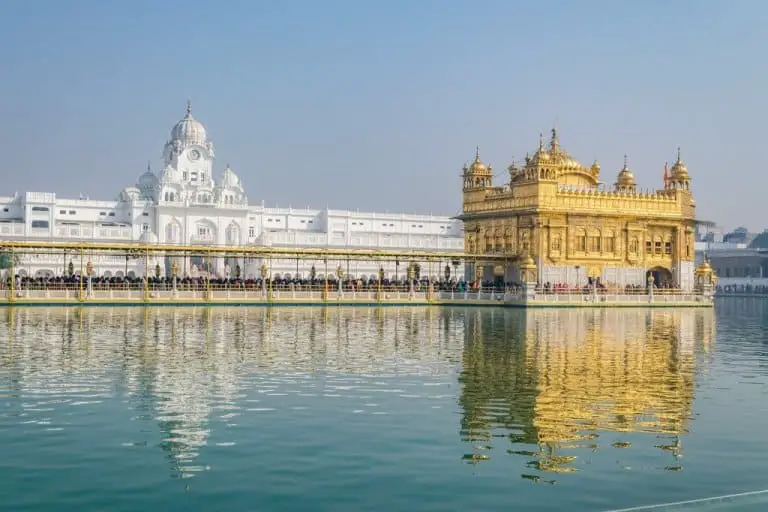
5. Eco-tourism Package
This type of tourism has become one of the fascinating forms of travel. Although eco-tourism is more of a travel philosophy, it attracts many tourists. Some eco-tourism destination areas include Kerala, Galgibaga Beach in Goa, and Coorg.
6. Cultural Tourism Package
The social richness of any country draws visitors from every corner of the world to witness sheer celebrations. The cultural tour package offers a comprehensive exploration of the different shades. Moreover, this package will provide tourists with a closer view of the traditions and architecture.
Along with these, we found tourism packages like-
7. Family Tourism Package
A family tour package is designed to keep the family’s needs in mind. It assures total relaxation and fun pastimes.
The package includes sightseeing trips, tours of historical sites, and adventure activities suitable for adults, children, and seniors.
8. Honeymoon Tourism Package
After their marriages, couples take a honeymoon tour package, which provides newlyweds with all the perquisites to make their trip memorable.
The honeymoon tourism package includes lodgings, dining, food, and drinks. The Maldives, Bali, and Mauritius are famous destinations for a honeymoon tour package.
9. Wellness Tourism Package
Traveling to other places for health and well-being takes a wellness tourism package. Tourists take this package to visit sites that provide recuperation facilities. Wellness tourism has seen a significant boost in recent years.
Popular destinations for a wellness tourism package include Ayurveda centers, Iceland (for its spas), and Bali (for yoga), among others.
10. Cruise Tourism Package
A cruise tourism package provides tourists with a journey filled with fun and recreational activities onboard and excursions onshore.
Tourists book a thoroughly planned ship or boat trip to a specific location at a fixed price for a designated date. These packages are curated to meet the needs of tourists.
What are Tourism Products?
According to market needs, customers supply products for use or consumption. A product can be offered in the market for observation, purchase, use, or any need or demand.
Tourism products are provided to tourists during their travels. It mainly focuses on facilities and services designed to meet their needs.
It includes physical objects, services, personalities, places, and ideas. One company or a group of companies provides the above components. Tourism products can be given to tourists in a tourist destination.
Products are needed for leisure, pleasure, religious, or business purposes. These products are provided in the market at a cost.
The main reason for choosing a tourist destination is the tourism product. It provides the destination with an economic boost, so it needs to be marketed and stored efficiently and hassle-free.
Services are designed to fulfill the visitor’s needs. Therefore, it is a combination of products. Thus, the country’s total tourism and tourist satisfaction depend on the sum of its attractions, transportation, accommodations, entertainment, and other related factors.
Individual service providers, such as hotels, airlines, travel agencies, etc, provide every element of a tourism product. Therefore, you can analyze the attractiveness, accommodation, and accessibility of these products.
Types of Tourism Products
Attractions: It is one of the main elements. Tourists will not be encouraged to visit certain places without attractions. Attractions are the ingredients. The product influences a tourist’s decision to visit a specific destination.
Attractions include archaeological, cultural, and historical buildings, monuments, beach resorts, mountains, flora and fauna, national parks, trade fairs, arts and music festivals, exhibitions, and games. Nowadays, tourists are susceptible to changes in fashion.
Accessibility: It means how easily a visitor can reach the attraction. Tourists visit the attraction destination using different modes of transport. They see their predetermined location by car, motorcycle, train, ship, boat, airplane, or cycle.
The place becomes very affordable if it lacks good transportation systems. Tourist centers should be located near tourist-producing markets. It is connected to a network of efficient transportation to receive the largest number of tourists.
Accommodation: Another tourism product is accommodation. Tourism is an essential part—the tourist destination must have hotels, guest houses, camping, and homestays. If accommodation is not possible at the central location, an alternate arrangement should exist, at least some distance away.
Hospitality is a major factor in the development of a tourist destination in the future. The location’s restaurants, pubs, cafes, food, and beverage offerings enhance its attractiveness.
Natural tourism products: Nature is beautiful and precious to us. Nature has arranged amazing features in various parts of the world, including hills, mountains, caves, glaciers, the sea, islands, beaches, waterfalls, rivers, lakes, and diverse wildlife, as well as deserts.
The tourism product utilizes these natural gifts as a Natural tourism product, such as the snow-capped mountains in Kashmir, Dudhsagar Falls in Goa, the palm-fringed beaches of Goa, the wildlife of Kaziranga National Park in Assam, and the Thar Desert in Jaisalmer, among others.
Read Things to do in Bainbridge Island, Seattle, Washington
Human-created tourism products
Artificial tourism products are those that humans create. Human-made tourism products, such as Temples, Forts, palaces, museums, theme parks, etc., are primarily designed to attract tourists.
The destination’s tradition and culture play a vital role in tourism. Humans maintain it to attract tourists through classical dance, music, folk dance, paintings, handicrafts, festivals, fairs, etc.

Examples: Machu Picchu World Heritage Site, Egyptian pyramids, Taj Mahal, Red Fort in Agra, Lothal in Gujarat, Mexican pyramids, or Mesoamerican pyramids are important archaeological sites.
The Bhangra dance form of Punjab, the Kolkata Book Fair, the Durga puja in Kolkata, the Brass work of Muradabad, etc., are also included in human-made tourism products.
Tour guides are another main aspect of traveling and a parameter for tourism. National and international travelers need a travel guide to discover a new place, but they may also visit any tourist destination alone.
But an international traveler always wants a good tourist guide. How do you present the location, and how much information do you provide to understand the place? It depends on a guided tour and a travel guide. This parameter upgrades the tourist destination’s level.
What are the different types of tourist destinations?
Although the terms “tourism” and “tourist destinations” may sound synonymous, they have slight conceptual differences. Tourism is a broader concept that includes the aspects of tourism and hospitality.
At the same time, a tourist destination is a narrower concept applying to places of tourist attraction. Based on the type of place and the causes of interest, the tourist’s destinations are:
- Coastal Destinations: Coastal destinations are preferred mostly for the ample sunshine and salty waters lining the lands adjoining the sea. Whether domestic or international, coastal locations are great for fun and relaxation. They are favored mostly by people living in inland areas away from the sea.
- Beaches – The land and ocean meeting point offers a great tourist attraction. Waves hitting the shores of sandy beaches are great for tourists. In addition, new beach activities like parasailing, beach biking, etc., also attract tourists immensely.
- Island – A land in the middle of the sea or ocean on all sides is an island. Tourists are mainly taken from the mainland to explore these islands by boat. Islands standing in between a river are called riverine islands.
- Mangroves: It offer a panoramic view amidst the confluence of a river with the sea or ocean. An example is the Sundarbans of India.
- Inland Destinations – Travel away from the coast is an inland destination. A variety of sub-classifications can come under:
Based on the type of region:
- Hill stations – Offering a surreal view from an altitude, all mountains and hills are great tourist destinations.
- Jungles—Trekking/hiking/driving through wild greenery is a great tourist attraction. Protected areas like Reserve Forests and National Parks serve the twin purposes of tourism and conservation.
Based on the population structure
- Rural—For a change, get away from the fast-paced urban life to taste village life. Touring rural locations is gaining popularity due to their lower population density, greener landscapes, and serene environments.
- Urban – Posh urban destinations offer a pull factor for tourists to experience ultra-modern and urban life. Examples: New York, Shanghai, etc.
- Offbeat – Previously undiscovered newer locations around famous tourist spots are offbeat destinations. With lower tourist popularity, the exclusiveness of these places is retained.
Based on the type of activity
- Hiking and Camping—Places where tourists come mostly for hiking or camping (day/night) are fast gaining popularity. These places are primarily located amidst nature and fall under the category of adventure tourism.
- Preserved sites—Sites like UNESCO World Heritage sites have become popular tourist destinations. Their rich natural and cultural value owes them their status.
Based on historical/religious importance
- Historical Places & Monuments—Tourists flock to places holding remnants of the past. Areas with historic architecture and events give an insight into the past culture. Examples: the Taj Mahal and Jalianwallah Bagh, etc.
- Pilgrimages & Holy Shrines: Religious tourism has flourished here, making it a spiritual destination. An example is the Hajj of Mecca, a Christian pilgrimage to Bethlehem.
- Museums and buildings: Places where artifacts and remnants of historical culture are well preserved. Famous among tourists of all ages.
Based on entertainment
- Luxury destinations: Locations that only promote high-end tourism are luxury destinations. Example: Bali.
- Carnival: Countries host cultural events to celebrate special occasions for a short period each year. When tourists travel to enjoy themselves, the destination becomes a popular one. An example is the Christmas Carnival in Toronto.
- Amusement Park and Zoo: Famous for its attractions is Disneyland, a great tourist destination for children. Singapore Zoo ushers in global tourists.
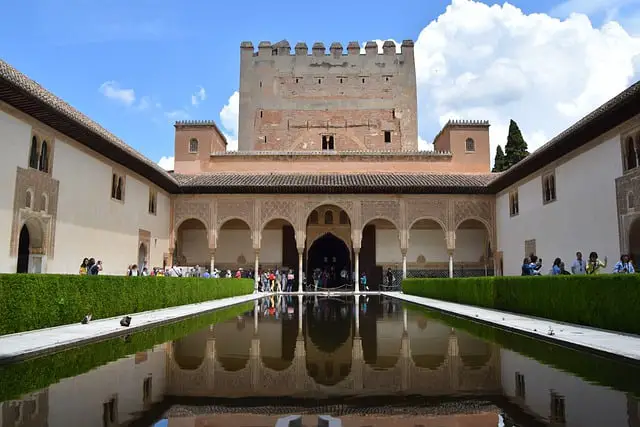
Tourism Destinations
According to UNWTO, in the “World’s Top Tourism Destinations,” France, Spain, the United States, and China are the top four destinations for international tourism.
A tourism destination is the endpoint of the journey. Of course, we all have some goals in every field, and tourism is the same.
There are various types of tourist destinations. They are as follows:-
- Centered Destination
- Based Destination
- Multi-centre Destination
- Touring Destination
- Transit Destination
Types of Tourist Attractions
- Historial attractions
- Cultural attractions
- Political significance
- The natural or scenic beauty
- Leisure travel
- Fun and Amusement
How many Types of Tourism are there in India?
There are 16 Different kinds of tourism in India, but the list may increase.
Is there anything about tourism that I’ve missed?
Over the past 75 years, the travel industry has made great strides in harmoniously uniting strangers, travelers, and locals. As a result, visits and travel are more than just an adventure; they are also about learning new skills, rejuvenation, and achieving perfection.
Tourism has changed from providing services like rooms, flights, and meals that people were satisfied with ten years ago. Now, people want to experience activities such as whale watching or mountain biking.
In the luxury sector, wealthy people spend more money on experiences than on objects. This is called experience economics, and the idea is that the memories of tourist values are compared to some physical resources. The number of global tourists is increasing daily, and every country is striving to develop and prosper its tourism sector.
As you can see, the tourism industry is vast and diverse. There are different kinds of tourism here; some have been around for decades, and others are just emerging.
Which type of tourism would a tour to the Grand Canyon fall under?
Grand Canyon tour falls into natural adventure tourism. Here, you can enjoy the Floor–Landing Helicopter Tour, ATV, Gold Mine Tour, White Water Adventure Tour, and Rim Airplane Tour.